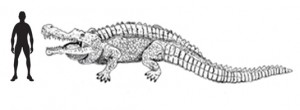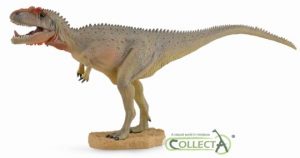Argentinosaurus, Mapusaurus, Sarcosuchus et al
And so the fifth instalment of the BBC television series “Planet Dinosaur” is reached. This episode entitled “Giant Killers” introduced a number of new prehistoric animals such as the nest raider Skopiovenator, an abelisaurid formally named and described just two years ago as well as some dinosaurs that are already very familiar to dinosaur fans. One of those dinosaurs regarded as “familiar” would be Argentinosaurus (A. huinculensis), recognised as the largest dinosaur known to science, indeed the largest terrestrial animal of all time.
With an estimated length of thirty-five metres and a mass of seventy-five tonnes, the programme makers did their best to convey the sheer size of this titanosaur, we liked the clever use of the small ornithopods running alongside. Interestingly, the footprint death traps that proved so fatal to these are not from South America, but China. The programme rather glossed over this point. The treacherous trackways have been associated with the sauropod Mamenchisaurus, although ichnologists would argue that it is difficult to assign a genus to a set of tracks unless a specimen representing the animal that made them is found fossilised at the trackway’s end.
Giant Killers
The main thrust of the programme seemed to focus on the fossil evidence to suggest that large carnivores (Theropoda and a prehistoric crocodile) lived alongside large herbivores (Sauropoda). The programme suggested that when the large herbivores became extinct, the large meat-eaters that depended on them soon died out as well. This is an extension of the predator/prey relationship that was discussed in earlier programmes.
The time lapse imagery showing the scavenging of a titanosaur carcase was for us, the highlight of this particular episode, although it was a pleasure to see Sarcosuchus (prehistoric crocodile) once again. This eight tonne super-croc was first seen in episode one “”Lost World”. The narration claimed that Sarcosuchus was the biggest crocodile. From what the fossil record shows, it was certainly was the biggest in that part of the world during the Cretaceous, but other crocodiles such as Deinosuchus and the much later Purussaurus could lay claim to being the biggest crocodile of all time.
An Illustration of Sarcosuchus
Picture credit: Everything Dinosaur
To view models and replicas of prehistoric animals such as Sarcosuchus, take a look at the CollectA Age of Dinosaurs Popular model range: CollectA Age of Dinosaurs (Popular).
The South American theropod Mapusaurus (Mapusaurus roseae) was also introduced. We suspect that for many young dinosaur fans, this is a new meat-eater for them. The fossils of this dinosaur come from the Huincul Formation in the Rio Negro and Neuquen provinces of Argentina. This carnivore was a contemporary of Giganotosaurus and may have been a pack hunter, an animal that weighed perhaps as much as six tonnes.
Still our favourite has to be Sarcosuchus, I guess we just have a soft spot for those big crocodiles.
CollectA Deluxe Prehistoric Animal Models
The manufacturer CollectA have recently produced some dinosaur figures that are featured in the BBC televisioin series. For example, the company has added a scale model of Mapusaurus to their prehistoric animal model range (whilst stocks last): CollectA Mapusaurus and Other Scale Model Dinosaurs.
A Replica of the Cretaceous Dinosaur Mapusaurus








Leave A Comment